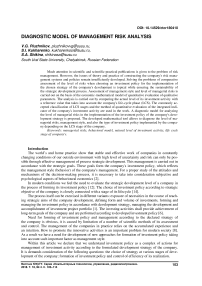Diagnostic model of management risk analysis
Автор: Pluzhnikov V.G., Kukharenko S.I., Shikina S.A.
Рубрика: Управление в социально-экономических системах
Статья в выпуске: 4 т.18, 2018 года.
Бесплатный доступ
Much attention in scientific and scientific-practical publications is given to the problem of risk management. However, the issues of theory and practice of constructing the company's risk management systems and policies remain insufficiently developed. Solving the problems of comparative assessment of the level of risks when choosing an investment policy for the implementation of the chosen strategy of the company's development is topical while ensuring the sustainability of the strategic development process. Assessment of management style and level of managerial risks is carried out on the basis of the economic-mathematical model of quantitative evaluation of qualitative parameters. The analysis is carried out by comparing the actual level of its investment activity with a reference value that takes into account the company's life-cycle phase (LCS). The commonly accepted classification of LCS stages and the method of quantitative evaluation of the integrated indicator of the company's investment activity are used in the work. A diagnostic model for analyzing the level of managerial risks in the implementation of the investment policy of the company's development strategy is proposed. The developed mathematical tool allows to diagnose the level of managerial risks, management style, and also the type of investment policy implemented by the company depending on the LCS stage of the company.
Managerial risks, behavioral model, natural level of investment activity, life cycle stage of company''s
Короткий адрес: https://sciup.org/147232208
IDR: 147232208 | УДК: 519.876.2 | DOI: 10.14529/ctcr180410
Список литературы Diagnostic model of management risk analysis
- Чараева, М.В. Формирование инвестиционной политики предприятия / М.В. Чараева // Финансовый менеджмент. - 2010. - № 2. - С. 97-104.
- Gradinaru, A. The Contribution of Behavioral Economics in Explaining the Decisional / A. Gradinaru // Process Procedia Economics and Finance. - 2014. - Vol. 16. - P. 417-426. DOI: 10.1016/S2212-5671(14)00821-1
- Greiner, L.E. Evolution and Revolution as Organizations Grow // Readings in Strategic Management. - 1989. - Р. 373-387. DOI: 10.1007/978-1-349-20317-8_25
- Ивашковская, И.В. Жизненный цикл организации и агрегированный показатель роста / И.В. Ивашковская, Д.О. Янгель // Корпоративные финансы. - 2007. - № 4. - С. 97-110.
- Кухаренко, С.И. Анализ параметров бизнес-процессов социально-экономической системы методом главных компонент / С.И. Кухаренко, В.Г. Плужников, С.А. Шикина // Вестник ЮУрГУ. Серия «Экономика и менеджмент». - 2015. - Т. 9, № 4. - С. 57-62. DOI: 10.14529/em090409
- Кушелевич, Е.Ю. Модели жизненных циклов организаций / Е.Ю. Кушелевич, С.Р. Филонович // Менеджмент: век XX - век XXI. - М.: Экономистъ, 2004. - С. 304-320.
- Lester, D.L. Organizational Life Cycle: A Five-Stage Empirical Scale / D.L. Lester, J.A. Parnell, S. Carraher // The International Journal of Organizational Analysis. - 2003. - 11 (4). - P. 339-354.
- DOI: 10.1108/eb028979
- Lin, Y.T. Dynamics of human innovative behaviors / Y.T. Lin, X.P. Han, B.H. Wang // Physica A: Statistical Mechanics and its Applications. - 2014. - 15 (394). - P. 74-81.
- DOI: 10.1016/j.physa.2013.09.039
- Miller, D. Learning across the life cycle: Experimentation and performance among the Hollywood studio heads / D. Miller, J. Shamsie // Strategic Management Journal. - 2001. - 22 (8). - P. 725-745.
- DOI: 10.1002/smj.171
- Применение метода собственных состояний для анализа и прогнозирования социально-экономических систем / В.В. Мокеев, О.С. Буслаева, С.В. Воронина и др. - Челябинск: Издат. центр ЮУрГУ, 2016. - 162 с.
- Мюллер, Д. Теория жизненного цикла фирмы / Д. Мюллер // Журнал промышленной экономики. - 1972. - 20 (3). - P. 199-219. DOI: 10,2307 / 2098055
- Плужников, В.Г. К вопросу об анализе параметров бизнес-процессов производства методом собственных состояний на примере промышленного предприятия / В.Г. Плужников, С.А. Шикина // Управление экономическими системами: электрон. науч. журн. - 2014. - № 70. - http://uecs.ru/uecs70-702014/item/3087-2014-10-18-08-24-48.
- Плужников, В.Г. К вопросу оценки этапа жизненного цикла предприятия / В.Г. Плужников, С.А. Шикина // Экономический анализ теория и практика. - 2015. - № 44 (443). - С. 53-64.
- Плужников, В.Г. Диагностика как инструмент обеспечения экономической безопасности предприятия / В.Г. Плужников, С.И. Кухаренко, С.А. Шикина // Вестник ЮУрГУ. Серия «Экономика и менеджмент». - 2017. - Т. 11, № 1. - С. 36-44.
- DOI: 10.14529/em170105
- Shefrin, H.M. The behavioral life-cycle hypothesis / H.M. Shefrin, R.H. Thaler // Economic Inquiry. - 1988. - Vol. 26. - P. 609-643.
- DOI: 10.1111/j.1465-7295.1988.tb01520.x
- Широкова, Г.В. Характеристика стадий жизненного цикла российских компаний, созданных «с нуля» / Г.В. Широкова // Российский журнал менеджмента. - 2007. - Т. 5, № 4. - С. 3-20.
- Смагин, В.Н. Регрессионный анализ зависимости уровня инвестиционной активности от этапа производства жизненного цикла / В.Н. Смагин, С.А. Шикина // Вестник ЮУрГУ. Серия «Экономика и управление». - 2012. - № 9 (268). - С. 88-90.
- Wielhouwer, J.L. Optimal dynamic investment policy for different tax depreciation rates and economic depreciation rates / J.L. Wielhouwer, A. De Waegenaere, P.M. Kort // Journal of Optimization Theory and Applications. - 2000. - 106: 23.
- DOI: 10.1023/A:1004650906179
- Young, D. Economic Value-Added: A Primer for European Managers / D. Young // European Management Journal. - 1997. - Vol. 15. - P. 335-343.
- DOI: 10.1016/S0263-2373(97)00014-5


